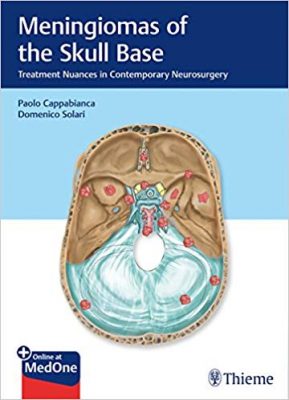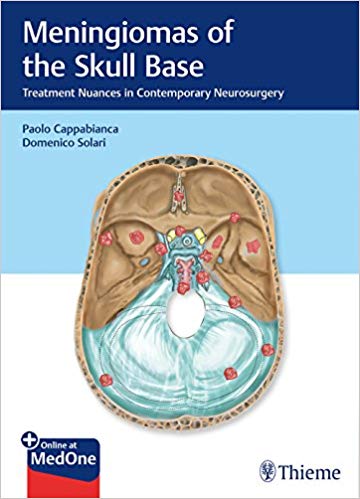 Editors: Paolo Cappablanca, MD and Domenico Solari, MD
Editors: Paolo Cappablanca, MD and Domenico Solari, MD
Publisher: Thieme – 208 pages, with 292 illustrations
Book Review by: Nano Khilnani
It was as early as 1884 when the treatment of intracranial meningiomas began, according to Dr. Enrico Divitiis, the writer of the Foreword to this book. That was when the Italian surgeon Francesco Durante removed an olfactory groove meningioma from a patient. It was such a remarkable procedure that its details deserved publication in The Lancet.
But since then, “the longstanding and alive debate concerning the best treatment strategy and understanding of the clinical and biological behavior of meningiomas has represented a challenging matter for the neurological community,” writes Dr. Divitiis.
On the one side, there are those who contend that because of their benign nature, total removal leads to effective cure, and consider this treatment as a gold standard. On the other hand there are those who oppose such a strategy because of the tumor’s surrounding involvement with skull base bone, dura, and neurovascular structures, and its tendency to recur in higher grades of histologic subtypes, making complete removal challenging.
These and other matters are discussed in this excellent text that is valuable because of these great features:
- Discussion of pathology and therapy organized by anatomic location of the les0ons with the goal of providing best patient outcomes
- New World Health Organization meningioma classification system based on most recent research in growth patterns, gene sequencing, and molecular patterns of development
- Important updates on the newest developments in treatment modalities in meningiomas, including the lesser invasive radiotherapy and radiosurgery for the smaller lesions and to avoid the necessity of performing radical surgery
Sixty-two neurosurgeons and specialists in neurology as well as in advanced biomedical sciences, the odontostomatological sciences, otolaryngology, pathology, radiation oncology, reproductive sciences, and skull base surgery – from around the United States and seven other countries namely Chile, Egypt, France, Germany, India, Italy, and Serbia – authored the 20 chapters of this book of extensive and intensive coverage on meningiomas.
We list the titles of the chapters here to provide you a broad overview of the coverage of this book:
- Introduction
- The Evolution of Surgery – The Soul of Neurosurgery
- Inside the Pathology
- Exogenous Factors Affecting Meningiomas
- Instrumentation (Micro, Endo, IGS, MRI Application)
- Intraoperative Neurophysiologic Monitoring during Surgery
- Role of Stereotactic Radiosurgery
- Sphenoid Wing Meningiomas
- Clival Meningiomas
- Petroclival Meningiomas
- Olfactory Groove Meningiomas
- Middle Fossa Floor Meningiomas
- Cerebellopontine Angle Meningiomas
- Foramen MGNUM Meningiomas
- Tubercullum Sellae/Planum Meningiomas
- Cavernous Sinus Meningiomas
- Reconstruction of the Skull Base
- Management of Recurrent Skull Base Meningiomas
- Natural History and Adjunctive Modalities of Treatment
- Complications in the Management of Skull Base Meningioma
Additional content is available online. You can also access your complimentary online version directly at https://MedOne.Thieme.com by retrieving the access code on the inside front cover of this book.
Meningiomas are one of the most common types of tumors in the brain, but their locations are numerous and their range of variety is broad. Because of these factors, differential diagnosis is challenging and the decision-making process on the best treatment option for a particular type of tumor can be difficult.
This must-have book provides you a large amount of highly detailed information on the different types of skull base meningiomas, their diagnosis, and treatment.
Editors:
Paolo Cappablanca, MD is Professor and Chairman of Neurosurgery, and Director of the Neurosurgery Residency Program in the Division of Neurosurgery at the University of Naples Federico II in Naples, Italy.
Domenico Solari, MD, PhD is Assistant Professor of Neurosurgery in the Division of Neurosurgery at the University of Naples Federico II in Naples, Italy.
Foreword:
Enrico Divitiis, MD is Professor Emeritus of Neurosurgery at the University of Naples Federico II in Naples, Italy.







